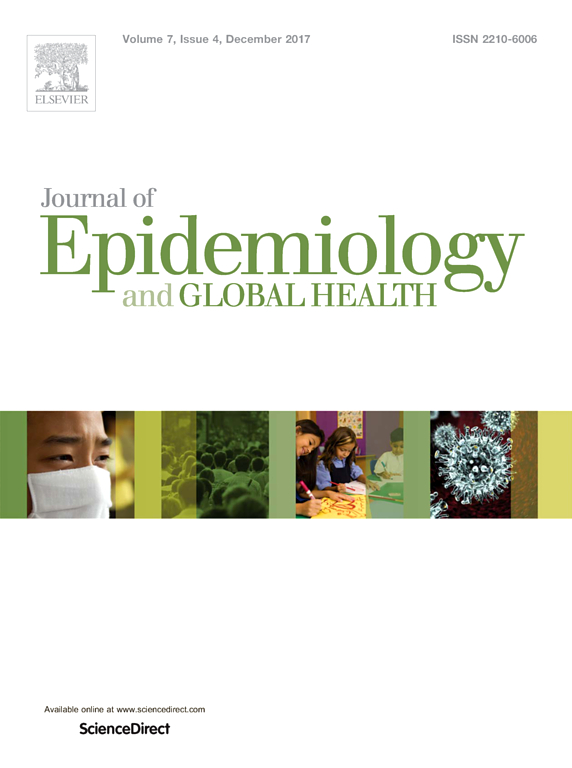绝经后妇女的多特征体形表型与乳腺癌风险:英国生物库队列的因果中介分析。
IF 3.8
4区 医学
Q1 PUBLIC, ENVIRONMENTAL & OCCUPATIONAL HEALTH
引用次数: 0
摘要
结合多种人体测量特征的体形表型与绝经后乳腺癌(BC)有关。然而,人们对其背后的生物学途径仍然知之甚少。本研究调查了体型与绝经后乳腺癌风险之间的关联在多大程度上是由生化标志物介导的。研究对象包括英国生物库中的 176,686 名绝经后妇女。通过对身高、体重、体重指数、腰围和臀围以及腰臀比(WHR)进行主成分(PC)分析,得出了四种体型表型。总效应的四向分解用于同时估计中介效应和交互效应以及中介比例。经过 10.9 年的中位随访,共诊断出 6396 例绝经后乳腺癌。有强有力的证据表明,PC1(全身肥胖)和 PC2(身材高大、低 WHR)与 BC 风险之间存在正相关。PC1与BC风险的关系受睾酮的正向介导,受胰岛素样生长因子-1(IGF-1)的负向介导,介导的总比例(介导的相互作用和纯间接效应(PIE)之和)分别占总效应的11.4%(95%置信区间:5.1%至17.8%)和-12.2%(-20.5%至-4.0%)。IGF-1(PIE:2.8%(0.6% 至 4.9%))和性激素结合球蛋白(SHBG)(PIE:-6.1%(-10.9% 至-1.3%))在 PC2 与 BC 之间的关联中占很小比例。我们的研究结果表明,不同体型与乳腺癌风险之间存在不同的关联途径,一般肥胖体型与乳腺癌风险之间的关系可能是通过睾酮和IGF-1介导的,而IGF-1和SHBG可能介导高大/清瘦体型与乳腺癌风险之间的关系。本文章由计算机程序翻译,如有差异,请以英文原文为准。
Multi-Trait Body Shape Phenotypes and Breast Cancer Risk in Postmenopausal Women: A Causal Mediation Analysis in the UK Biobank Cohort.
Body shape phenotypes combining multiple anthropometric traits have been linked to postmenopausal breast cancer (BC). However, underlying biological pathways remain poorly understood. This study investigated to what extent the associations of body shapes with postmenopausal BC risk is mediated by biochemical markers. The study included 176,686 postmenopausal women from UK Biobank. Four body shape phenotypes were derived from principal component (PC) analysis of height, weight, body mass index, waist and hip circumferences, and waist-to-hip ratio (WHR). The four-way decomposition of the total effect was used to estimate mediation and interaction effects simultaneously as well as the mediated proportions. After 10.9 years median follow-up, 6,396 incident postmenopausal BC were diagnosed. There was strong evidence of positive associations between PC1 (general obesity) and PC2 (tall, low WHR), and BC risk. The association of PC1 with BC risk was positively mediated by testosterone and negatively by insulin-like growth factor-1 (IGF-1), with the overall proportion mediated (sum of the mediated interaction and pure indirect effect (PIE)) accounting for 11.4% (95% confidence intervals: 5.1 to 17.8%) and -12.2% (-20.5% to -4.0%) of the total effect, respectively. Small proportions of the association between PC2 and BC were mediated by IGF-1 (PIE: 2.8% (0.6 to 4.9%)), and sex hormone-binding globulin (SHBG) (PIE: -6.1% (-10.9% to -1.3%)). Our findings are consistent with differential pathways linking different body shapes with BC risk, with a suggestive mediation through testosterone and IGF-1 in the relationship of a generally obese body shape and BC risk, while IGF-1 and SHBG may mediate a tall/lean body shape-BC risk association.
求助全文
通过发布文献求助,成功后即可免费获取论文全文。
去求助
来源期刊

Journal of Epidemiology and Global Health
Medicine-Epidemiology
CiteScore
10.70
自引率
1.40%
发文量
57
审稿时长
19 weeks
期刊介绍:
The Journal of Epidemiology and Global Health is an esteemed international publication, offering a platform for peer-reviewed articles that drive advancements in global epidemiology and international health. Our mission is to shape global health policy by showcasing cutting-edge scholarship and innovative strategies.
 求助内容:
求助内容: 应助结果提醒方式:
应助结果提醒方式:


